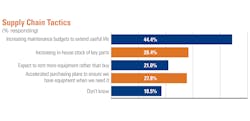We live in interesting times, and as this proverb is often considered a curse, it is appropriate to consider the negative aspects of fleet management as 2022 winds down.
This is just a short list of circumstances looming in 2023 and beyond. Lead times on new equipment pushing a year and, in some cases, more. New equipment prices increasing. Rental fleets aging. Diesel shortages possible and price volatility continuing.
Equipment professionals are revisiting the tried and true methods of asset management. The hour meter may indicate a machine has reached its sweet spot, but managers who would typically take the automatic replacement find themselves reevaluating the decision. Price and availability push purchasing a new machine down the list of options. According to research done for our 2023 Annual Report and Forecast, which we will publish in partnership with Topcon Positioning Group, many equipment managers are bumping budget numbers for repair and maintenance rather than plan for purchasing new equipment in 2023. See that chart above.
See the complete 2023 Annual Report & Forecast.
Options exist, of course. In order to decide successfully which option works for a fleet, an equipment manager must know their costs. How much does a fleet spend on repair work in order to keep productivity at acceptable levels? For a fleet with a spot-on preventive maintenance program, equipment performance might be extended for months beyond planned replacement for a reasonable cost.
If a machine is not maintained properly, spending on repairs late in life in order to return it to productivity will snowball into expense after expense after expense. Replacing a nonproductive machine next year will cost more than budgeted, but it may be the most viable and financially rational option.
Two bright spots as we head into a year of “interesting” decisions are the quality of new equipment and the range of brand options. Machine technology enhances machine performance: Data aids management of the machine as asset, and technology such as machine control helps operators gain efficiency. Second, the wide range of manufacturers in the market offer equipment managers options as price and availability affect budgets and project schedule demands.
Next year holds much promise for the industry, but fielding the fleets needed to take advantage does not need to be cursed. Plan, manage, and execute wisely, but be nimble enough to not blindly depend on what’s worked in the past.
About the Author
Rod Sutton
Sutton has served as the editorial lead of Construction Equipment magazine and ConstructionEquipment.com since 2001.
Our mission is to help managers of heavy equipment and trucks to improve their performance in acquiring and managing their fleets. One way we do that is with our Executive Institute, where experts share information and ideas that will enable equipment managers to accurately manage equipment costs so that they can deliver the optimum financial benefits to their organizations.
We also have a laser focus on product development, performance, and technology; as well as equipment acquisition, disposal, and maintenance. Our exclusive Field Tests take earthmoving equipment and truck into the field for professional evaluations.
Check out our free newsletters to see the latest content.
You can find Sutton on LinkedIn.

